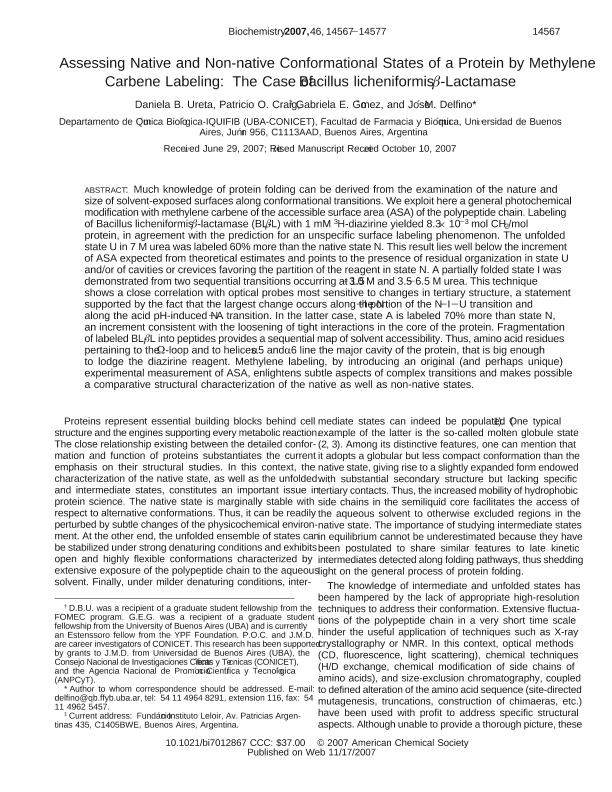Mostrar el registro sencillo del ítem
dc.contributor.author
Ureta, Daniela Beatriz

dc.contributor.author
Craig, Patricio Oliver

dc.contributor.author
Gomez, Gabriela Elena

dc.contributor.author
Delfino, Jose Maria

dc.date.available
2017-11-21T18:57:28Z
dc.date.issued
2007-11
dc.identifier.citation
Ureta, Daniela Beatriz; Craig, Patricio Oliver; Gomez, Gabriela Elena; Delfino, Jose Maria; Assessing native and non-native conformational states of a protein by methylene carbene labeling: the case of Bacillus licheniformis beta-lactamase; American Chemical Society; Biochemistry; 46; 50; 11-2007; 14567-14577
dc.identifier.issn
0006-2960
dc.identifier.uri
http://hdl.handle.net/11336/28661
dc.description.abstract
Much knowledge of protein folding can be derived from the examination of the nature and size of solvent-exposed surfaces along conformational transitions. We exploit here a general photochemical modification with methylene carbene of the accessible surface area (ASA) of the polypeptide chain. Labeling of Bacillus licheniformis beta-lactamase (BL-betaL) with 1 mM 3H-diazirine yielded 8.3 x 10(-3) mol CH2/mol protein, in agreement with the prediction for an unspecific surface labeling phenomenon. The unfolded state U in 7 M urea was labeled 60% more than the native state N. This result lies well below the increment of ASA expected from theoretical estimates and points to the presence of residual organization in state U and/or of cavities or crevices favoring the partition of the reagent in state N. A partially folded state I was demonstrated from two sequential transitions occurring at 1.5-3.0 M and 3.5-6.5 M urea. This technique shows a close correlation with optical probes most sensitive to changes in tertiary structure, a statement supported by the fact that the largest change occurs along the N-I portion of the N-I-U transition and along the acid pH-induced N-A transition. In the latter case, state A is labeled 70% more than state N, an increment consistent with the loosening of tight interactions in the core of the protein. Fragmentation of labeled BL-betaL into peptides provides a sequential map of solvent accessibility. Thus, amino acid residues pertaining to the Omega-loop and to helices alpha5 and alpha6 line the major cavity of the protein, that is big enough to lodge the diazirine reagent. Methylene labeling, by introducing an original (and perhaps unique) experimental measurement of ASA, enlightens subtle aspects of complex transitions and makes possible a comparative structural characterization of the native as well as non-native states
dc.format
application/pdf
dc.language.iso
eng
dc.publisher
American Chemical Society

dc.rights
info:eu-repo/semantics/openAccess
dc.rights.uri
https://creativecommons.org/licenses/by-nc-sa/2.5/ar/
dc.subject
Dzn
dc.subject
Methylene Carbene
dc.subject
Accessible Surface Area
dc.subject
Molten Globule
dc.subject.classification
Inmunología

dc.subject.classification
Medicina Básica

dc.subject.classification
CIENCIAS MÉDICAS Y DE LA SALUD

dc.title
Assessing native and non-native conformational states of a protein by methylene carbene labeling: the case of Bacillus licheniformis beta-lactamase
dc.type
info:eu-repo/semantics/article
dc.type
info:ar-repo/semantics/artículo
dc.type
info:eu-repo/semantics/publishedVersion
dc.date.updated
2017-11-03T20:23:28Z
dc.identifier.eissn
1520-4995
dc.journal.volume
46
dc.journal.number
50
dc.journal.pagination
14567-14577
dc.journal.pais
Estados Unidos

dc.journal.ciudad
Washington
dc.description.fil
Fil: Ureta, Daniela Beatriz. Consejo Nacional de Investigaciones Científicas y Técnicas. Oficina de Coordinación Administrativa Houssay. Instituto de Química y Físico-Química Biológicas "Prof. Alejandro C. Paladini". Universidad de Buenos Aires. Facultad de Farmacia y Bioquímica. Instituto de Química y Físico-Química Biológicas; Argentina
dc.description.fil
Fil: Craig, Patricio Oliver. Consejo Nacional de Investigaciones Científicas y Técnicas. Oficina de Coordinación Administrativa Houssay. Instituto de Química y Físico-Química Biológicas "Prof. Alejandro C. Paladini". Universidad de Buenos Aires. Facultad de Farmacia y Bioquímica. Instituto de Química y Físico-Química Biológicas; Argentina. Consejo Nacional de Investigaciones Científicas y Técnicas. Oficina de Coordinación Administrativa Parque Centenario. Instituto de Investigaciones Bioquímicas de Buenos Aires. Fundación Instituto Leloir. Instituto de Investigaciones Bioquímicas de Buenos Aires; Argentina
dc.description.fil
Fil: Gomez, Gabriela Elena. Consejo Nacional de Investigaciones Científicas y Técnicas. Oficina de Coordinación Administrativa Houssay. Instituto de Química y Físico-Química Biológicas "Prof. Alejandro C. Paladini". Universidad de Buenos Aires. Facultad de Farmacia y Bioquímica. Instituto de Química y Físico-Química Biológicas; Argentina
dc.description.fil
Fil: Delfino, Jose Maria. Consejo Nacional de Investigaciones Científicas y Técnicas. Oficina de Coordinación Administrativa Houssay. Instituto de Química y Físico-Química Biológicas "Prof. Alejandro C. Paladini". Universidad de Buenos Aires. Facultad de Farmacia y Bioquímica. Instituto de Química y Físico-Química Biológicas; Argentina
dc.journal.title
Biochemistry

dc.relation.alternativeid
info:eu-repo/semantics/altIdentifier/url/http://pubs.acs.org/doi/abs/10.1021/bi7012867
dc.relation.alternativeid
info:eu-repo/semantics/altIdentifier/doi/https://dx.doi.org/10.1021/bi7012867
Archivos asociados
